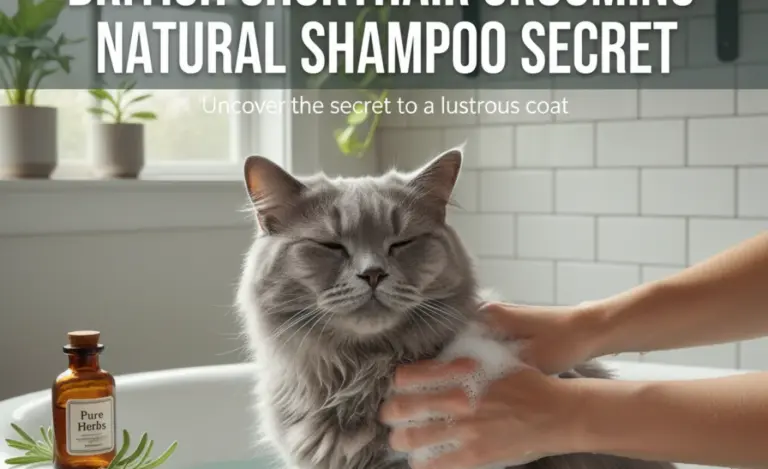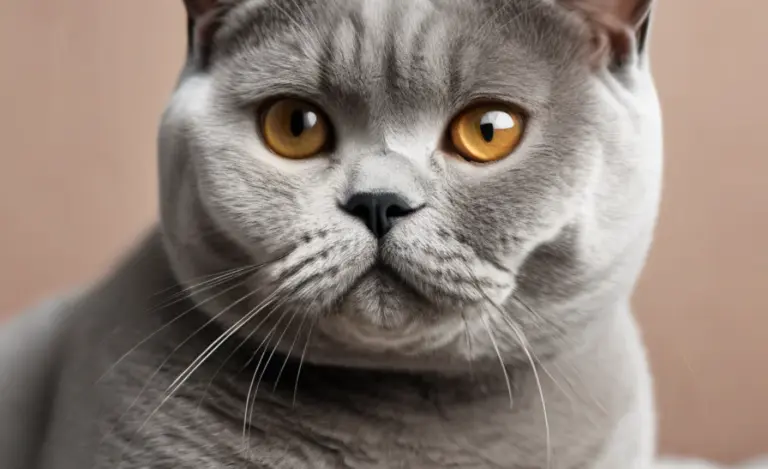British Shorthair Grooming for Hairball Reduction: Secret?
Grooming your British Shorthair helps reduce hairballs by removing loose fur before your cat swallows it. Regular brushing, ideally a few times a week, is key. Use quality tools like a slicker brush and a deshedding tool. A healthy diet and plenty of water also support healthy coat and digestion.
Is your British Shorthair coughing up hairballs? It’s a common worry for us cat parents! These adorable furballs are prone to shedding, and all that grooming can lead to hairballs. But don’t worry, it’s manageable! With the right grooming routine, you can keep your kitty comfortable and your carpets clean.
We’ll walk through easy steps to reduce hairballs. You’ll learn how often to brush, which tools work best, and how diet plays a big role. Soon, you and your British Shorthair can enjoy a happier, less hairy life!
Understanding Hairballs in British Shorthairs
British Shorthairs are known for their dense, plush coats. While beautiful, this fur can cause problems when your cat grooms. As they lick, they swallow loose hair. Usually, this passes through their digestive system without issue. But sometimes, it clumps together, forming a hairball. Your cat then tries to get rid of it – often, well, you know how! It’s not pleasant for them or for you.
Why are British Shorthairs prone to hairballs? Their thick coat sheds more than some other breeds, especially during seasonal changes. Plus, they are meticulous groomers! All that licking adds up.
Why Grooming Matters
Regular grooming is the best way to control hairballs. Brushing removes loose hair before your cat can swallow it. This reduces the amount of hair in their stomach, preventing hairball formation. It’s also a lovely bonding experience for you and your feline friend!
Step-by-Step Grooming Guide
Ready to start grooming? Here’s how to do it right:
Step 1: Gather Your Supplies
Before you begin, collect your grooming tools. Here’s what you’ll need:
- Slicker Brush: Great for removing loose fur and tangles.
- Deshedding Tool: Designed to reach deep into the coat and remove undercoat.
- Metal Comb: Helps to detangle and smooth the fur.
- Soft Cloth: For a final polish and to remove any remaining loose hair.
Step 2: Start with a Gentle Brush
Begin with the slicker brush. Gently brush your cat’s coat in the direction of hair growth. Be extra careful around sensitive areas like the belly and legs. This step removes surface-level loose fur and any small tangles.
Step 3: Use the Deshedding Tool
Next, use the deshedding tool. Gently run it through your cat’s coat, following the direction of hair growth. Don’t press too hard – let the tool do the work. You’ll be amazed at how much fur this removes! This tool is especially helpful during shedding season.
Step 4: Comb Through the Fur
Use the metal comb to check for any remaining knots or tangles. Gently work through any mats you find. If a mat is too tight, consider using scissors to carefully cut it out. Be very cautious not to cut your cat’s skin.
Step 5: Finish with a Soft Cloth
Dampen a soft cloth with warm water and gently wipe down your cat’s coat. This removes any remaining loose hair and leaves their fur looking shiny and healthy. It also feels nice for your cat!
How Often Should You Groom?
The frequency of grooming depends on the season and your cat’s individual shedding habits. Here’s a general guideline:
- Regular Season: Brush 2-3 times per week.
- Shedding Season (Spring/Fall): Brush daily or every other day.
Pay attention to your cat’s coat. If you notice more shedding, increase the frequency of grooming. Regular grooming prevents hairballs and keeps their coat healthy.
Choosing the Right Grooming Tools
Not all grooming tools are created equal. Here’s a comparison of popular options:
| Tool | Pros | Cons | Best For |
|---|---|---|---|
| Slicker Brush | Removes loose fur, detangles, good for daily use | Can be uncomfortable if used too harshly | General grooming, removing surface fur |
| Deshedding Tool | Reaches deep into the coat, removes a lot of fur | Can irritate skin if used too often or too hard | Heavy shedding, thick undercoats |
| Metal Comb | Detangles, smooths fur, good for finishing | May not remove as much loose fur as other tools | Checking for mats, smoothing the coat |
| Grooming Gloves | Gentle, good for sensitive cats, massages while grooming | May not be as effective for heavy shedding | Cats who dislike brushes, light grooming |
Choose tools that are comfortable for your cat and effective for their coat type. Always prioritize gentle handling.
Diet and Hairball Control
Grooming is essential, but diet also plays a big role in hairball management. Certain foods can help reduce hairballs by improving digestion and coat health.
Hairball-Specific Foods
Consider feeding your British Shorthair a hairball-specific food. These formulas often contain higher fiber levels, which help move hair through the digestive system. They may also include ingredients that promote a healthy coat, reducing shedding.
Omega-3 Fatty Acids
Omega-3 fatty acids support healthy skin and coat. This can reduce shedding and minimize hairball formation. You can add omega-3 supplements to your cat’s diet or choose foods that are rich in these essential fats. Fish oil is a great source.
Hydration is Key
Make sure your cat has access to plenty of fresh water. Proper hydration helps keep the digestive system running smoothly, which can prevent hairballs. Consider adding a cat water fountain to encourage drinking.
Other Tips for Hairball Reduction
Besides grooming and diet, here are some extra tips to help manage hairballs:
- Hairball Lubricants: These gels or pastes help hairballs pass through the digestive system. They coat the hair, making it easier to move along.
- Regular Vet Checkups: Ensure your cat is healthy and doesn’t have any underlying digestive issues.
- Avoid Over-Grooming: Stress or boredom can lead to excessive grooming. Provide plenty of toys and playtime to keep your cat entertained.
Dealing with Existing Hairballs
Despite your best efforts, your British Shorthair may still develop hairballs. Here’s how to handle them:
Recognizing the Signs
Know the signs of a hairball. These include:
- Coughing or hacking
- Retching or gagging
- Vomiting hairballs
- Loss of appetite
- Constipation
If you notice these signs, take action to help your cat.
Helping Your Cat
If your cat is trying to pass a hairball, give them space and be patient. Offer them a small amount of hairball lubricant or a teaspoon of plain canned pumpkin (not pie filling), which can help move things along. Make sure they have access to fresh water.
When to See a Vet
Most hairballs are harmless, but sometimes they can cause serious problems. See a vet if your cat:
- Is repeatedly trying to vomit without producing a hairball
- Has a decreased appetite for more than 24 hours
- Is constipated
- Shows signs of lethargy or weakness
These could be signs of a more serious blockage that requires medical attention. According to the Cornell Feline Health Center, persistent vomiting or constipation can be a sign of intestinal obstruction, which is a medical emergency.
Creating a Positive Grooming Experience
Grooming should be a pleasant experience for both you and your cat. Here’s how to make it enjoyable:
Start Early
Introduce grooming to your British Shorthair kitten as early as possible. This helps them get used to the sensation of being brushed. Keep the first sessions short and positive.
Use Positive Reinforcement
Reward your cat with treats, praise, or petting during and after grooming. This creates a positive association with the experience.
Be Gentle
Always handle your cat gently. Avoid pulling or tugging on their fur. If they become agitated, stop and try again later.
Find the Right Time
Choose a time when your cat is relaxed and receptive to grooming. Avoid grooming when they are hungry, playful, or stressed.
The Importance of Regular Veterinary Care
Regular vet checkups are crucial for your British Shorthair’s overall health. Your vet can identify any underlying health issues that may contribute to hairball problems. They can also provide advice on diet, grooming, and other aspects of cat care.
Dental Health
Dental health is often overlooked but is vital for your cat’s well-being. According to the International Cat Care organization, dental disease is common in cats and can impact their overall health. Regular dental checkups and cleanings can prevent problems.
Vaccinations and Parasite Control
Keep your cat up-to-date on vaccinations and parasite control. These protect them from common diseases and ensure they stay healthy.
Common Mistakes to Avoid
Here are some common mistakes to avoid when grooming your British Shorthair:
- Using the Wrong Tools: Make sure you’re using tools that are appropriate for your cat’s coat type.
- Brushing Too Hard: Be gentle to avoid irritating their skin.
- Ignoring Mats: Address mats promptly to prevent them from becoming worse.
- Forcing Grooming: Never force your cat to be groomed. This can create negative associations.
- Not Seeking Professional Help: If you’re struggling to groom your cat, consider seeking help from a professional groomer.
British Shorthair Grooming for Hairball Reduction: A Summary
Here’s a quick recap of everything we’ve covered:
- Regular Grooming: Brush your cat 2-3 times a week, more during shedding season.
- Right Tools: Use a slicker brush, deshedding tool, and metal comb.
- Healthy Diet: Feed a hairball-specific food and ensure plenty of water.
- Hairball Lubricants: Use gels or pastes to help hairballs pass.
- Vet Checkups: Schedule regular vet visits for overall health.
By following these tips, you can significantly reduce hairballs and keep your British Shorthair happy and healthy!
Frequently Asked Questions (FAQs)
Here are some common questions about British Shorthair grooming and hairball reduction:
How often should I brush my British Shorthair?
Brush your British Shorthair 2-3 times a week during normal seasons and daily during shedding season (spring and fall).
What type of brush is best for a British Shorthair?
A combination of a slicker brush, a deshedding tool, and a metal comb works best. The slicker brush removes loose fur, the deshedding tool tackles the undercoat, and the comb helps with detangling.
Can diet help with hairballs?
Yes, a diet rich in fiber and omega-3 fatty acids can help reduce hairballs. Hairball-specific foods are also a good option.
Are hairball treats effective?
Hairball treats, such as lubricants, can help hairballs pass through the digestive system more easily. Use them as directed by your vet.
What are the signs of a hairball problem?
Signs include frequent coughing, gagging, vomiting hairballs, loss of appetite, and constipation. If these symptoms persist, consult your vet.
Is it normal for my cat to vomit hairballs?
Occasional hairballs are normal, but frequent vomiting is not. If your cat is vomiting hairballs more than once a month, take them to the vet.
How can I make grooming more enjoyable for my cat?
Start grooming early, use positive reinforcement (treats and praise), be gentle, and choose a time when your cat is relaxed.
Conclusion
Managing hairballs in your British Shorthair doesn’t have to be a constant battle. With a consistent grooming routine, a healthy diet, and a few extra tips, you can keep those pesky hairballs at bay. Remember, regular brushing is your best defense! A little effort goes a long way in keeping your feline friend comfortable and your home hairball-free. By understanding their coat and needs, you’ll not only reduce hairballs but also strengthen the bond with your beloved British Shorthair. So, grab those brushes, and let’s get grooming!




